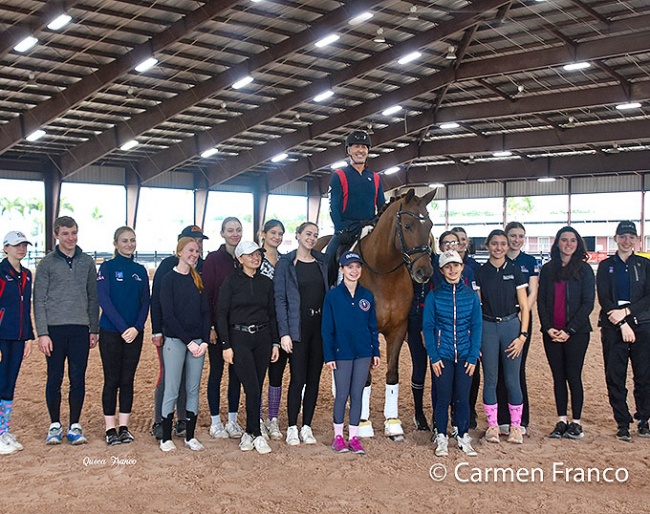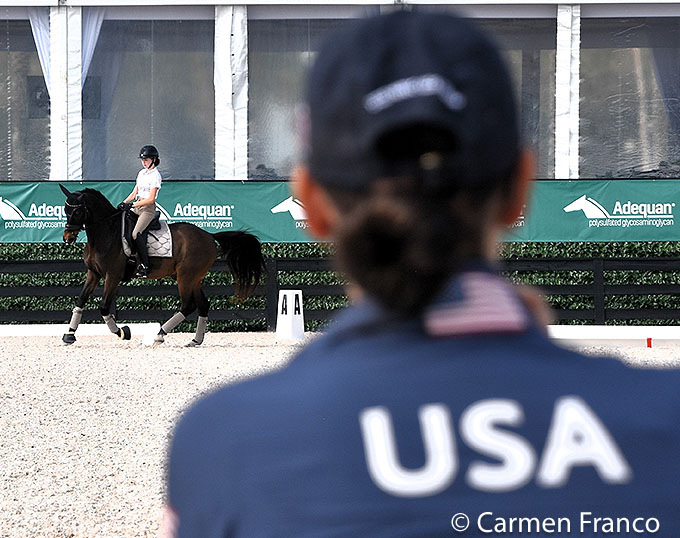
-- Text and Photos © Carmen Franco for Eurodressage
Wellington's winter season has countless competitive events in the jumping and dressage circuits, as well as in polo tournaments. Learning opportunities are not far behind. Recently the Robert Dover Horsemastership Clinic was held at the Global Dressage Festival.
Powered by Dressage4Kids
The Horsemastership Clinic was founded in 2011 by Lendon Gray, who with her unstoppable passion to educate the youth in the United States through her hyperactive enterprise Dressage4Kids (D4K) joined forces with six-time Olympian Robert Dover.
Lendon, in the company of Laurie Moore, remembered the first clinic when Laurie brought Kerrigan Gluch from Michigan on a borrowed horse. “It was held at WEF, the jumper showgrounds, for the first couple of years; then moved here, to where the Global Dressage Festival is hosted," said Lendon. "Kerrigan’s horse could not perform so she borrowed another one from Kim van Kampen at Hampton Green Farm.”
That was the beginning of a wonderful story: at just 27 years of age Kerrigan developed into a successful FEI competitor and got to represent the USA in a Nations Cup at the 2023 CDIO 4* Rotterdam. She works for Hampton Green Farm.
The purpose of these clinics is to provide extraordinary educational opportunities to a select group of young riders who have demonstrated talent for the future.
The Participants in the 2024 Edition

Professionals of the caliber of Alison Brock, Sarah Tubman, Olivia LaGoy-Weltz, and Katie Duerrhammer were in charge of the riding sessions this year. In addition, participants received instruction / workshops from various professionals who discussed topics around the horse industry.
Education from Start to Finish

Thursday morning, we witnessed a beautiful presentation by Robert Dover on his 7-year-old Oldenburg gelding Vitalissimo (by Vitalis x Bellisimo). Robert bought him at the Oldenburg auction and reared him in Holland. He was first trained by Dutch Danielle Houtvast before being shipped to Dover in Wellington. In his just second outing from his barn, the horse was a joy to watch: he moved around the ring happily, relaxed, and supple on a snaffle, while Robert did not have spurs nor whip. He reminded everyone of his talk from the previous day, where the main purpose of the rider is to work in harmony with the horse. “It is really not about the perfection of the breed / conformation, but more about the willingness of the horse to be trained," he said.

Here are a few takeaways from the sessions:
Tiny Rider, Huge Horse Means Effective Aids!
Jenaya Olsen started the day with Alison Brock on the beautiful gray DSP gelding London Fog MDF (by Lloyd George out of Noblesse VI). Despite Ali asking her to do her own warm-up and she would give her input later, the coaching started quite quickly after the first steps. He was castrated late in life and some of the stallion behaviour of being behind the leg has stayed. “The walk is a place where the horse likes to keep the rider hostage," said Brock. Jenaya is a tiny rider, and London Fog is a huge horse who was a jumper that switched careers not long ago. Also, their partnership is just a couple of months old. Ali asked her to get him to yield to her inside leg, staying in circle lines all the time. When tapping with the whip, London Fog wanted to piaffe, so Ali instructed her to touch at the place of her leg, or at the horse’s shoulders. Several attempts were made to get London Fog more honest in his reactions and some of them were more successful than others.

When the time came to start the canter, they were asked to really develop a 1,2,3 rhythm and to be sure the rider could access both sides of the horse’s body. “Imagine you are the pole of a carousel horse; that can help you stay in the correct balance without tipping forward or falling backwards.” Finding that steadiness in the rider’s position will help you be more effective with your aids. Without a doubt, London Fog is of a lot of quality, but is a little tricky to ride. Ali reminded Jenaya to stick to the basics and make him more honest to the aids. “Make sure you keep your First Level horse in your Grand Prix horse!”
Straightness is Key
Lexie Kment came with her Sir Limoncello (Hanoverian 2017 gelding, Scolari out of Lady Lemon) to the sessions with Katie Duerrhammer. From the start the focus was on the straightness. As they did straight lines and circles in the warm-up, Katie insisted on having true alignment through every ridden figure. “When he tilts as you use your rein to make him straight, be sure you bring that side hindleg under his body. Look for the nose to be aligned with the center of his chest.”

By working these fundamentals, the rider can focus on changing the balance and make the horse transfer the weight to the hindlegs, thus creating more uphill feel and self-carriage. “Be brave and experiment with giving!” Katie reassured her that, if he wanted to lean forward, they could achieve better corrections by stretching the hands forward instead of hanging backwards.
When the time came for a break, the walk became pulled from the front instead of being active from behind. Katie asked her to slow him down as it was difficult to bring the hindlegs to the center of gravity with the shoulders moving so fast. “It will be difficult for him to lift the back walking like that. Also, do not use your leg all the time to keep him in front, there are many other tools.” They went on to work on transitions trot – walk, asking her to be picky about his reactions. The connection got better!
At the canter, they worked on leg-yieldings from the quarter line to the track to help bring the balance back. Attention had to be put on the alignment of the leg-yielding.
The takeaway of this session was to teach the young horse with soft, correct aids but be sure to be effective in accomplishing things. “There is a difference between making them do it versus teaching them how to do it.”
Your Body Will Affect His Body
Even though each coach has its own style, when Olivia Lagoy-Weltz worked with Emma Claire Stephens and De Nouvelle Vie (Dutch Warmblood gelding, 2008, Vivaldi out of Issandra) you can clearly see they all go back to the same principles of riding. While the warm-up was easy and fluent, Olivia thought it could have more “oomph” in the canter. “When I see his body, I think he could have more muscle, not because he is in poor condition, just because the work towards self-carriage can make more bulk in the body.”

In the trot, they played with forward and back within the gait, in rising and sitting trot, looking for more cadence. Olivia reminded her to keep the hindlegs active when collecting and encouraged her to tap him with the whip so he would not slow down.
There were moments where Nouvelle tried to lock in the base of the neck and Olivia told Emma to keep bringing the hindlegs under the body, work through the back so she could access the area with the hands forward. If his back is up, he can be ridden properly into lightness and suppleness again.
Connection Wonders

They continued working at the trot trying to find the correct timing for giving with the hands. Unscripted’s trot became bouncier and in more self-carriage to what Alex showed a bright smile. Sarah encouraged her to keep looking for the “show trot” through millions of transitions. When he builds his strength and stamina, he will be able to hold that trot for the length of the test. Finding that trot meant that she needs to slow him down: “spend time teaching him to be more earthbound, if he is too quick in his steps, he will not bounce easily.” There were moments where the pony curled or poked his nose too far out, and Sarah told Alex to stay calm, to keep riding his body though half-halts until finding his thoroughness, balance, and suppleness. “The more you keep riding like this, the more comfortable he will feel.”

The session demonstrated that it takes time to change and teach things, but following a clear, simple, but steady path will be key to success.
Your Body Will Affect His Body - Part Two
The last session I was able to attend was almost the same concept as the one with Olivia and Emma. Alison Brock worked with Elizabeth Petersen and Worthy Aspirations (Hanoverian mare, 2010, by Worthy Opponent V.E. out of Dominica V) around her position and how to influence in the best possible way.

Today, Elizabeth was allowed to work around the arena and perform different exercises. They did leg-yieldings at the trot, where Ali asked her to be quicker with her aids. “If you were playing video games of you riding, you would be already dead with that speed. Be ready!”
At the canter they worked on the timing to apply the leg aid when the mare went up and to give when the mare went down in the stride. Elizabeth was encouraged to really open the canter following with swinging elbows when Ali asked for an extension. The same as in other lessons, they were asked not to let the mare slow down when collecting after an extension. That could be done if the rider’s aids stayed quick.
There were several adjustments to the position while performing movements and Ali asked Elizabeth a few times to identify the problem spot. That was her way to be sure the rider was feeling correctly, so she could improve. “If I see tension, I want the rider to identify where.”

The mare became quite forward after Elizabeth unlocked her body allowing them to start working on half-halts. To avoid getting tighter, Ali suggested to do parts of the work in sitting trot and others in rising. It was nice to see how minor changes started happening with more harmony and suppleness.

Other Activities
There were other topics besides the riding sessions: they worked on stable management, physio evaluations, nutrition, sports psychology, and freestyles workshops; they even had a media strategies talk, and a workshop about shoeing.
Without a doubt, an invaluable week for these young riders!
Related Links
Participants for the 2024 Robert Dover USEF Horsemastership Clinic Week
2023 U.S. Lusitano Conference - Pedro Torres: "Teach Your Horse the Code"
2023 U.S. Lusitano Conference - Kyra Kyrklund: "Repetitions to Make and Break a Habit"
Carl Hester's Wisdom: "Dedicate Yourself to Get Better, Nobody is Perfect"
Nuggets of Wisdom from the 2023 USDF FEI Level Trainers' Conference